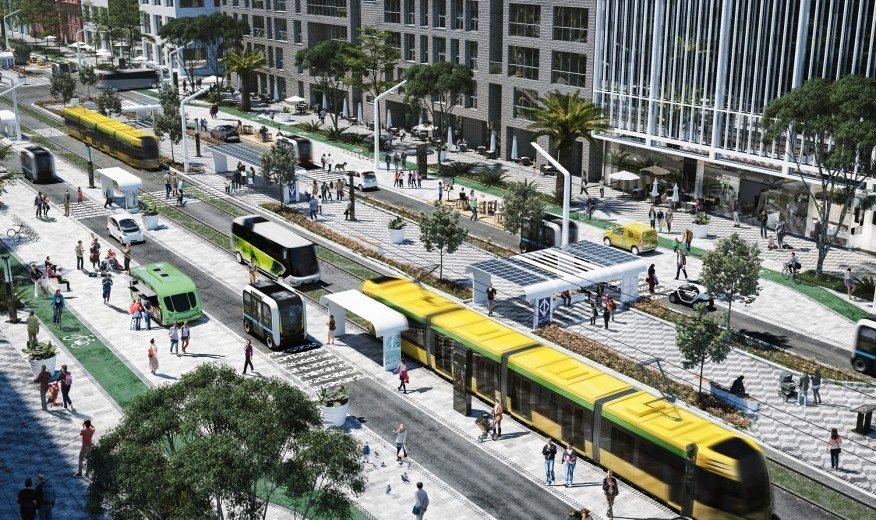
Seven Implications of Multimodal And Shared On-Demand Mobility
On-demand mobility services continue to evolve fast. New solutions are introduced constantly to address changes in consumer urban transportation tastes, or address shortcomings of existing offerings. Consumers demand for personalized transportation solutions that are affordable, convenient, and safe has led to the rapid growth of ride-hailing. But in cities where it is most popular, single passenger ride-hailing is a major contributor to traffic congestion and lengthening travel times leading to deteriorating passenger experience. We need to find solutions that increase the passenger throughput per mile and permanently remove vehicles from streets. Micromobility and new forms of ridesharing emerged in part to address these problems but also to provide lower cost transportation alternatives. They are now being combined with ride-hailing to offer multimodal transportation. Multimodal and shared on-demand mobility will have seven implications that will require careful consideration.
Reasonable prices, high convenience, and generally good safety continue to drive the broad popularity of ride-hailing in many urban areas globally, as demonstrated by skyrocketing Vehicle Miles Traveled (VMT). Ride-hailing’s level of convenience has been achieved due to a) the short wait times for an ordered ride, b) each ride starting and ending at exactly the locations desired by the passenger, c) the ability to summon a ride from a mobile application, and d) benefit from all the useful information such applications provide. Short wait times became possible because of the recruiting efforts by the major Transportation Network Companies (TNCs) to bring more drivers into their networks. More available drivers meant faster response to a particular ride request. Reasonably-priced rides became possible primarily because of ample driver supply and the discounting afforded by the massive capital infusions the sector has received.
We are starting to recognize that in the cities where it is popular, e.g., New York, San Francisco, Chicago, Los Angeles, Seattle, ride-hailing has become a major factor in worsening traffic congestion and lower speeds. These trends are due to two reasons. First, ride-hailing is resulting in more vehicles to be added to the transportation system. For example, ride-hailing has resulted in 45,000 new vehicles being added to San Francisco’s traffic. Ride-hailing is not leading to the removal of any privately-owned vehicles from city streets. Consumers continue to use their own vehicles for their daily commute and use ride-hailing primarily for short rides, i.e., less than 6 miles. The average US daily commute 16 miles each way. The Vehicle Miles Traveled using privately owned vehicles dominate the distribution total VMT in urban and suburban areas. The cost per mile of privately-owned vehicles remains lower than that of ride-hailing services making uneconomical to use this service to commute such distances. Second, data is also showing that for every revenue-generating mile ride-hailing vehicles spend on the average 0.6 empty-miles. We define as empty miles the miles travelled a) while waiting for the next ride, b) going to the starting location of the next ride, or c) driving to a refueling/recharging station or maintenance depot. As a result of these trends ride-hailing’s passenger experience is deteriorating.
In order to effectively address the worsening urban traffic congestion we need to find solutions that a) increase the passenger throughput per mile, while providing high convenience, and b) permanently remove privately-owned vehicles from streets. For example, public transportation modalities have the ability to move up to 25,000 passengers per hour but they are often criticized for infrequent and inconvenient service. Privately owned vehicles can move only up to 1,600 per hour. This implies that consumers should decrease the use of:
- Privately-owned, single occupant vehicles for their daily commute;
- Single passenger ride-haling services, regardless of whether they employ human-driven or, eventually, autonomous vehicles, the so-called robotaxis.
Instead they should increase the use of transportation solutions with higher throughput per mile, particularly for the daily commute and other longer distance rides. Increasing passenger throughput means that we a) extensively adopt ride-sharing on-demand mobility services, and b) effectively utilize multimodal transportation particularly solutions that combine effectively on-demand mobility services with public transportation. But this may not be the public transportation that we now today with big buses that often carry very few passengers and infrequent service.
A range of on-demand shared mobility solutions is already available today. From shared ride-hailing, e.g., UberPool, to fixed-route microtransit, e.g., Chariot, and dynamic-route microtransit, e.g., Via. Shared ride-hailing has lower passenger throughput per mile than microtransit. But it provides higher convenience because each passenger is picked up and dropped off at their exact desired locations. To date none of these variants has proven as successful as single passenger ride-hailing. The just-announced closure of Chariot, provides another unsuccessful microtransit effort. However, the worsening traffic congestion that is leading to longer travel times and results in a deteriorating ride-hailing passenger experience, may change this trend, if not globally at least in certain geographies.
Micromobility services emerged from the recognition that because many of the intraday trips that consumers take are short they may not require the use of an automobile. Micromobility consists of bike-sharing (docked and dockless), and scooter/escooter-sharing. The thinking goes that by using bikes, ebikes, and escooters a consumer can navigate around the congestion, thus reducing the time of travel, and get to their intended destination economically, thus reducing the cost of travel. Micromobility offers low per mile cost, convenience of readily finding bikes, ebikes, and escooters in many areas, and generally good user experience that is enabled through the mobile applications used and the technology on board the bikes and escooters, even as it comes with the reduced safety of operating bikes and escooters in environments that are clogged with cars and trucks. Micromobility’s popularity grew within a short time and is surpassing the adoption of other on-demand mobility services such as various forms of ridesharing, and of car sharing.
TNCs could not ignore the quick consumer adoption of micromobility. After initially incorporating micromobility options to their ride-hailing services they proceeded with investments in, acquisitions (and here) of companies offering such services, as well as their own internal technology development. Combining of micromobility with ride-hailing offers a strong indication that we are transitioning from monomodal to multimodal on-demand mobility. Leading TNCs like Uber, and Lyft are constantly expanding their multimodal transportation options and in some instances they even offer coordinated connections to public transportation.
Ford was the first automotive OEM to embrace micromobility when it started operating GoBike. More recently Ford announced the acquisition of Spin, an escooter company. GM has also signaled its intentions to produce ebikes. However, both OEMs remain behind Uber and Lyft in the deployment of such solutions. Other incumbent OEMs that had started to develop businesses around a single on-demand mobility service, have also started to consider micromobility and multimodal transportation services through partnerships, investments, and internal development.
A Framework For Evaluating On-Demand Mobility Services
In a previous post I presented a four-dimensional framework for analyzing and comparing the companies offering on-demand mobility services, particularly ride-hailing. The framework uses: price, convenience, passenger experience, and safety. We can utilize the same four dimensions to rate and compare five types of on-demand mobility services: ride-hailing, ridesharing, car sharing, micromobility, and microtransit. In these qualitative evaluations the absolute ratings are not as important as are the relative positions of each type of service along the framework’s dimensions. Because travel distance is an important criterion on the services used, I have considered three ranges:
Rides of up to 2 miles. These rides can be completed using micromobility, microtransit, ridesharing, and ride-hailing. However, micromobility and microtransit are ideally suited for these distances. My qualitative evaluation of using each of these mobility services for rides involving such distances is shown in Figure 1. One conclusion from the analysis of Figure 1 is that people who can and are willing to use micromobility for such distances have better passenger/user experience and similar convenience for a lower price but also lower safety than the users of ride-hailing and ridesharing services.
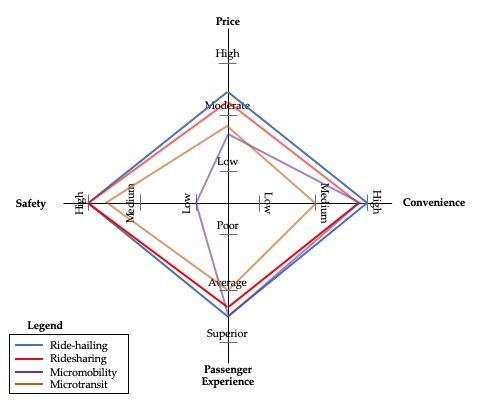
Figure 1: Comparison of on-demand mobility services for rides of up to 2 miles
Rides between 2 and 6 miles. These rides can be completed primarily using microtransit, ridesharing, and ride-hailing. Micromobility services are not out of the question for this range but they become problematic for most people for distances that are over 2 miles. My qualitative evaluation of using each of these mobility services on their own for rides involving such distances is shown in Figure 2.

Figure 2: Comparison of monomodal on-demand services for rides of 2-6 miles
One conclusion from the analysis of Figure 2 is that ridesharing provides a good option for this distance range to consumers who can accommodate the longer rides (due to the multiple stops) and the experience of sharing vehicle with other passengers.
Figure 3 shows how this assessment changes when a few of these services are combined to provide multimodal transportation solutions for rides within this range.

Figure 3: Comparison of multimodal on-demand services for rides of 2-6 miles
We can draw two conclusions from this analysis. First, for passengers who prefer ride-hailing, combining micromobility with ride-hailing could actually improve passenger experience in areas of high traffic congestion while delivering the service at better price but with some negative impact on safety and convenience. Second, along certain dimensions, the shortcomings of a single modality improve when multiple modalities are combined. It should also be noted that the use of autonomous vehicle fleets, initially in microtransit later on, as these vehicles become more capable and can operate in a greater variety of environments, in ride-hailing and ridesharing, will further improve the passenger experience and reduce price.
Rides that are longer than 10 miles. These rides can be completed using ride-hailing, ridesharing and car sharing. My qualitative evaluation of using each of these mobility services on their own for rides involving such distances is shown in Figure 4.
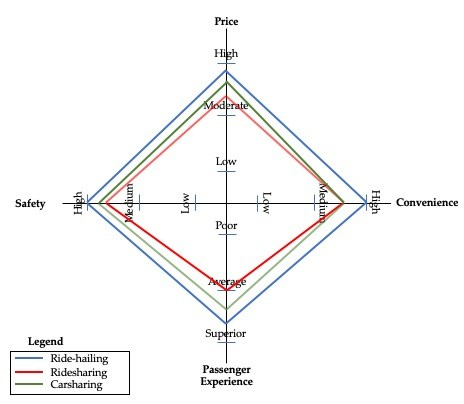
Figure 4: Comparison of monomodal on-demand services for rides > 10 miles
One conclusion that can be drawn from this analysis is that for these longer rides, car sharing provides a better experience than ridesharing at a lower price than ride-hailing.
Figure 5 shows how this assessment changes when a few of these services are combined to provide multimodal transportation solutions for rides within this range.
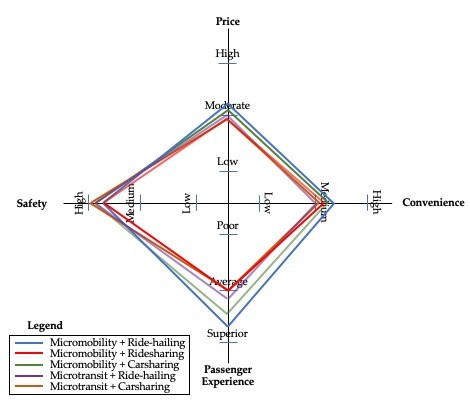
Figure 5: Comparison of multimodal on-demand services for rides > 10 miles
The conclusion is that for rides over 10 miles, multimodal transportation using only on-demand services doesn’t create as distinct advantages over corresponding monomodal options. As with the case of rides of 2-6 miles, the use of autonomous vehicle fleets in microtransit will improve the passenger experience and reduce the overall transportation cost.
Seven Implications of Adopting Multimodal and Shared On-Demand Mobility
As we adopt multimodal on-demand mobility services and broaden the use of shared mobility, first to offer Mobility as a Service (MaaS) and eventually Transportation as a Service (TaaS), we need to consider seven implications.
Implication 1: Multimodal transportation and ultimately Transportation as a Service will require work in four areas:
- On-demand mobility services and public transportation;
- Vehicle technology, including autonomous vehicle technologies, propulsion system technologies, etc.;
- Transportation infrastructure technology; and
- Information technology (software, hardware, services, e.g., cloud computing-based services such as AWS and Azure).
As is shown in Figure 6, work in these areas will involve the efforts of many industries, several of which are not traditionally associated with the automotive or transportation sectors.

Figure 6: The industries that will contribute to multimodal on-demand mobility
Corporations and startups will need to collaborate extensively to achieve the results necessary to make multimodal transportation broadly a reality.
Implication 2: As we move to multimodal on-demand mobility, we need to understand the importance of mobility orchestrators. These are the entities that coordinate transportation across modalities very much in the way that Air Traffic Control today coordinates transportation the skies. Mobility orchestrators optimize throughput, convenience, traffic flow, and other characteristics of a well-functioning transportation system, such as managing the curb. With such coordination we will be able to address ride-hailing pick-ups and drop-offs, the sidewalk congestion that is resulting from the uncontrolled deployment of escooters and bikes/ebikes, and others that have yet to be exhibited. Will the governments (city or state) or corporations be the mobility orchestrators? The traditional models used in the US that have city and state governments being the orchestrators of public transportation have largely been failing because the silos they create inhibit well-coordinated multimodal transportation. On the other hand, corporations will try to create walled-gardens around their transportation offerings that will limit the ability to coordinate across services outside their direct control.
Implication 3: The fleet-based on-demand mobility value chain must incorporate micromobility, microtransit, and the various forms of car sharing, e.g., Car2Go, and Maven. The companies offering these services operate vehicle fleets instead of being ride coordinators. Companies that provide multimodal on-demand transportation solutions will operate hybrid fleets comprising of vehicles appropriate for each offered modality. Over time, certain vehicles in these fleets may be autonomous. With the acquisition of micromobility companies, Transportation Network Companies like Uber and Lyft that started as ride coordinators have become fleet operators. The introduction of autonomous vehicles for ride-hailing and ridesharing will push them more in this direction.
Implication 4: In the short to medium term, i.e., before 2030, the introduction of autonomous vehicles (electrified or conventional) for on-demand transportation services by itself will not solve the congestion problem. AVs will only be a part of the solution, in some cases a very small part. In fact, introducing autonomous vehicles without removing from circulation more vehicles than those introduced will only worsen the traffic congestion. While consumers prefer riding alone, governments and corporations must collaborate to provide education about the benefits and incentives that encourage ridesharing, including ridesharing using AVs, as well as the use of public transit options as part of multimodal transportation solutions. Venture and private equity capital could also play a big role in subsidizing ridesharing, as it has done to date with ride-hailing. Only 50% of the average ride-hailing trip’s cost is covered by the fare. The rest is covered by the capital each ride-hailing company has raised. The use of AVs, starting with autonomous shuttles, has the potential to:
- Reduce the transportation modality’s cost and improve operating margins.
- Improve the modality’s safety.
- Optimize the modality’s fleet-wide efficiency, particularly when combined with an intelligent digital platform, by increasing the number of rides each such vehicle can perform per unit of time.
Over time, as a) more autonomous vehicles enter service, b) their capabilities enable them to operate in less constrained environments, c) AVs gain enduring consumer trust after being thoroughly tested and certified, much like airplanes are, under government standards that have yet to be established, and d) we succeed in removing vehicles from our roads, AVs will have a broader positive impact on the passenger experience as well.
Implication 5: Autonomous vehicles should be aggressively adopted by microtransit fleets. The autonomous vehicles that will be introduced in the near term will be capable of operating safely and reliably in a variety of microtransit use cases. These range from providing first/last mile connection to public transportation, to operating transportation in urban areas with traffic restrictions such as those that are starting to be adopted by a variety of cities around the world, to offering transportation on various campus types. Safety and reliability are two of the criteria cities will need to use in monitoring the performance of such vehicles. Cities will need to guarantee that these vehicles can operate with high safety and reliability in urban environments that include several vehicle types with varying levels of automation. In a companion piece I’m currently writing I examine autonomous vehicle performance along these dimensions and other dimensions.
Cities involved in early microtransit deployments of autonomous shuttles will learn important lessons that could prove pivotal to their transportation and urban planning. Depending on its circumstances, each city will be able to apply such lessons differently. But in each case we expect to see important benefits provided that cities start working closely with the companies offering these services using such vehicles.
Finally, through such collaborations even these early use cases will enable us to design and introduce a variety of autonomous vehicle form factors; from small pods that can carry 1-2 passengers and can be used for micromobility, to larger shuttles that can carry 6-15 passengers (May Mobility, EasyMile, and Transdev).
Implication 6: Fleet-based multimodal on-demand mobility will require intelligent backend digital platforms with big data and AI at their core. The complexity and sophistication of these platforms will surpass the data-driven digital platforms used today by companies offering monomodal mobility services. These backend platforms will utilize big data and AI for a variety of functions including trip planning and trip coordination across transportation modes, fleet management to maximize each vehicle’s uptime, and others. The management of the hybrid fleets used by companies offering multimodal transportation solutions is a hard problem to address. Consider the alternatives that such a platform will need to evaluate as it creates each personalized transportation solution to address a consumer’s needs while taking into account various modality combinations that maximize ridesharing, and optimize the passenger experience. For example, given a particular 5-mile ride request, what combination of modalities should be offered? Is the passenger interested in the ride with the lowest price, or the shortest time to destination? What restrictions do weather conditions, traffic conditions, and even the passenger’s condition impose on the transportation plan that will be recommended? In addition to the backend digital platforms being more complex, the consumer-facing applications of companies offering multimodal transportation must also be more intelligent in order to present different transportation plan options in a quickly digestible manner. To compete effectively with services that utilize such platforms incumbent OEMs will need to quickly develop expertise in such digital platforms and associated consumer-facing applications.
Implication 7: Vendors that transition to multimodal transportation, or intend to offer such services, i.e., vendors aiming at high convenience at a price, will need to operate three fleet types:
- Micromobility fleets consisting of escooters, bikes/ebikes, and eventually autonomous pods.
- Microtransit shuttle fleets comprised of conventional vans, and eventually appropriate forms of autonomous shuttles, that offer fixed and/or variable routing shared rides.
- Ride-hailing fleets that offer single passenger rides. These fleets may consist of conventional vehicles only, robotaxis only (including robotaxis that are designed and built specifically to address the population, traffic infrastructure and other characteristics of the geographic area they will serve) or be hybrid.
Ride-hailing popularized on-demand mobility services globally because of its convenience, price, safety, and passenger experience characteristics. In many urban areas we are now starting to feel the negative consequences of the ride-hailing’s popularity. Just using fleets of autonomous vehicles operated by mobility services companies to offer single passenger ride-hailing will not allow us to address the problem. We need to adopt solutions that significantly increase the passenger throughput per mile and remove automobiles from the roads. This will require solutions that combine shared mobility and multimodal transportation. And fleets that include autonomous vehicles to provide multimodal and shared on-demand mobility services can play a big role. As we begin to design and implement such solutions we need to understand their implications, and devise the right rollout strategies, and implementation plans.
The next article in the series.
The previous article in the series.



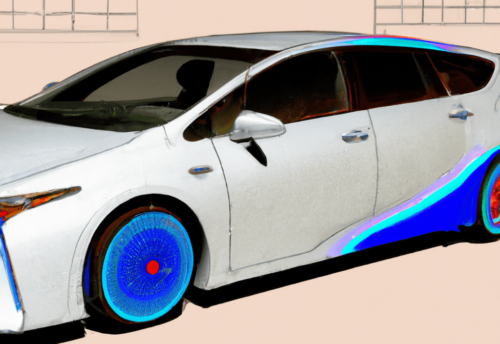
Leave a Reply